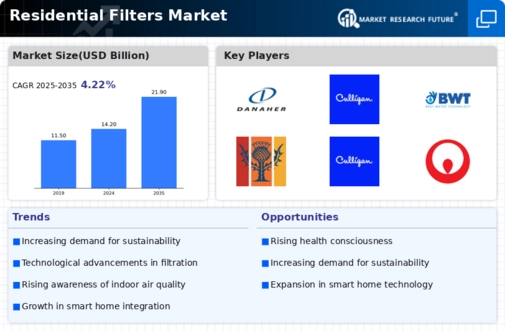Rising Water Quality Concerns
The increasing awareness regarding water quality is a pivotal driver in the Residential Filters Market. Consumers are becoming more cognizant of the contaminants present in their drinking water, such as lead, chlorine, and other harmful substances. This heightened concern is prompting households to invest in filtration systems to ensure safe and clean water. According to recent data, approximately 60% of households are now utilizing some form of water filtration, reflecting a significant shift in consumer behavior. As awareness continues to grow, the demand for advanced filtration technologies is likely to escalate, further propelling the Residential Filters Market.
Regulatory Standards and Compliance
Stringent regulatory standards regarding water quality are shaping the Residential Filters Market. Governments and health organizations are implementing regulations that mandate the reduction of specific contaminants in drinking water. These regulations compel manufacturers to innovate and improve their filtration technologies to meet compliance requirements. For instance, the introduction of new guidelines for lead levels in drinking water has led to an uptick in the adoption of residential filters. As compliance becomes increasingly critical, the market is expected to witness a surge in demand for high-performance filtration systems that adhere to these standards.
Increased Focus on Health and Wellness
The growing emphasis on health and wellness is significantly influencing the Residential Filters Market. Consumers are increasingly prioritizing their health, leading to a surge in demand for clean and safe drinking water. This trend is particularly evident among health-conscious individuals who are aware of the potential health risks associated with contaminated water. Market data indicates that households investing in water filtration systems have increased by over 30% in recent years, reflecting a shift towards healthier living. As this focus on wellness continues, the Residential Filters Market is poised for sustained growth.
Technological Innovations in Filtration
Technological advancements are revolutionizing the Residential Filters Market. Innovations such as reverse osmosis, UV purification, and smart filtration systems are enhancing the efficiency and effectiveness of water filtration. These technologies not only improve the quality of water but also offer convenience and ease of use for consumers. The market is witnessing a trend towards smart filters that can monitor water quality in real-time and alert users to potential issues. As these technologies become more accessible and affordable, they are likely to drive further growth in the Residential Filters Market, appealing to tech-savvy consumers.
Sustainability and Environmental Awareness
Sustainability concerns are becoming a driving force in the Residential Filters Market. As consumers become more environmentally conscious, there is a growing preference for filtration systems that reduce plastic waste and promote sustainable practices. Many households are opting for reusable filters and systems that minimize environmental impact. This shift is supported by data indicating that nearly 40% of consumers are willing to pay a premium for eco-friendly products. As sustainability becomes a key consideration in purchasing decisions, the Residential Filters Market is likely to adapt and innovate to meet these evolving consumer expectations.

















Leave a Comment